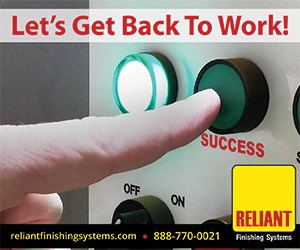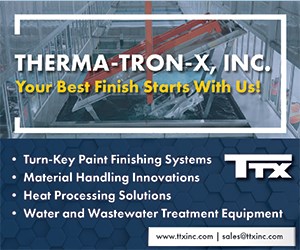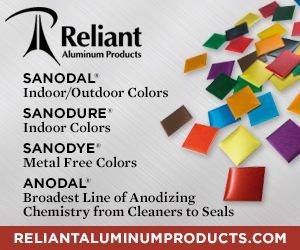MECHANICAL FINISHING
Narrow by Mechanical Finishing Product Category
- Abrasive Belts, Discs
- Abrasive Blasting Equipment, Dry
- Abrasive Blasting Equipment, Glass Bead
- Abrasive Blasting Equipment, Wet, Vapor
- Abrasive Blasting Materials
- Abrasive Grain
- Abrasives, Non-Woven Nylon
- Associations, Tradeshows & Professional Groups
- Backstand Idlers
- Balls & Shapes, Burnishing
- Barrel Lining Service
- Brushes, Cleaning & Polishing
- Buffing Compounds
- Buffing-Compound Applicators
- Buffs
- Burnishing Compounds
- Centrifugal Barrel or Disk Finishing Equipment
- Chemical-Polishing Processes
- Computer Control Systems for Finishing Processes
- Computer Software for Finishers
- Consultants, Independent, Buffing/Polishing
- Consultants, Independent, Mass Finishing
- Contact Wheels, Abrasive Belt
- Conveyor Belts
- Conveyor Cleaning Equipment
- Conveyor Loading/Unloading Equipment, Automatic
- Conveyor Lubricators
- Conveyors, Belt
- Conveyors, Chain-on-Edge Spindle-type
- Conveyors, Flat Pallet
- Conveyors, Inverted Power-and-Free
- Conveyors, Magnetic Belt
- Conveyors, Overhead Chain
- Conveyors, Overhead Power-and-Free
- Conveyors, Overhead Traveling Hoist
- Conveyors, Wicket
- Courses in Vibratory Finishing
- Deburring Equipment
- Deburring Equipment, Abrasive Flow
- Deburring Equipment, Processes, Electrochemical
- Deburring Equipment, Thermal
- Deburring Services
- Dryers, Vibratory
- Electropolishing Equipment
- Electropolishing Solutions
- Equipment Engineering & Installation Services
- Felt Wheels & Bobs
- Flapwheels
- Glass Beads
- Gloves, Work
- Inks, Metal Color-Coding
- Inks, Metal Decorating
- Lapping Supplies
- Lathes, Buffing & Polishing
- Lime, Burnishing & Polishing
- Lining Services for Tanks & Mass-Finishing Equipment
- Lubricants, Dry-Film or Solid-Film
- Lubricants, Polishing
- Mass-Finishing Compounds
- Mass-Finishing Media
- Mass-Finishing Supplies
- Noise-Control Enclosures, Devices
- Nozzles, Abrasive Blasting
- Polishing & Buffing Equipment, Automatic
- Polishing & Buffing Equipment, Hand-Held
- Polishing Machinery, Abrasive Belt
- Polishing Wheel Cement, Glue
- Polishing Wheels
- Robots, Deburring, Buffing, Polishing
- Rubbing Compounds
- Safety Equipment & Materials, Personal
- Safety Storage Buildings, Enclosures
- Sanders, Hand-Held
- Shot-Peening Equipment & Supplies
- Spindle Finishing Equipment
- Used Equipment
- Vibratory Finishing Equipment
FAQ: Mechanical Finishing
Can you recommend a process that can give a visual blasted finish?
Vibratory finishing can produce a visual finish very close to the tight patterned satin reflective blasted finish. Certain vibratory medias, compounds and machines are required. The high-energy centrifugal barrel works best, but vibratory machines also get close.
The two types of medias that work best in obtaining a blasted finish are a random shape 10- to 16-grit ceramic aluminum oxide media, or a smaller ¼ " to 3/8" polyester plastic cone or pyramid-shaped preformed media.
The random media works the best with both vibratory and centrifugal barrel machines and tends to lodge in holes. The smaller, pre-formed polyester media also works in a centrifugal barrel and vibratory processes. The vibratory compounds affect different surface brightness.
(Source: How to Produce a Visual Blasted Finish)
What media do you recommend for blasting stainless parts in a finer steel shot, while avoiding ferrous contamination?
Ceramic blast shot is our best recommendation. Stainless blast media is a standard recommendation, but keep in mind that stainless is 50-percent iron.
Ceramic blast media are spherical media with high mechanical strength and wear rates. Ceramic is impact-resistant and creates little dust. Ceramic shot maintains its round consistency and are chemically inert. Ceramic blast media processes produce a smooth, bright satin finish and the ceramic shot’s density creates higher impact speed, making it a good choice for deburring and peening.
Stainless blast media is available in shot (cut and conditioned wire, or caste) and is available in 304, 316, and 400 alloys. Stainless is a softer but heavier media that is a good choice for reduced blast process times, deburring, and reduced surface contamination. Stainless media produces a brighter finish with reduced blast machine wear.
Ferrous contamination on stainless surfaces in the welded affected areas is often caused by welding heat drawing the carbon to the surface. Blasting will not remove the carbon. Chemical passivation or electro-polishing is required to remove the carbon in the weld heat precipitation zones.
(Source: Mechanical Finishing Clinic: Blasting Media That Reduce or Eliminate Ferrous Surface Contamination)
We have a high-volume small stainless ½" × 1" part with a heavy external burr. We need to deburr the part in three seconds to obtain our production rates. How can we deburr and automate this part?
Abrasive finishing with a two-step process, using a combination of abrasive belts, fiber deburring wheels, or a nylon abrasive impregnated wheel will deburr 90 percent of most projects.
The abrasive deburring with a three-second process can be automated in two ways:
- An auto-indexing turntable with two deburring stations
- A robotic finishing cell with one feeder bowl feeding two small robots (each robot will take six seconds total to pick up the part, run two deburring processes and release the part; three seconds part output for the cell).
Abrasive finishing with two processes is a good way to deburr high-production parts. Automation can be accomplished by an auto-indexing turntable or a flexible robotic cell.
(Source: Automated Abrasive Finishing for High-Volume Production)
We are blasting heavy mill scales off of medium-sized parts in our suction blast cabinet with 80-grit aluminum oxide. We want to continue to blast by hand in a cabinet but would like to be more efficient. Can you suggest a quicker process?
Change your blast delivery system to a pressure pot blast cabinet to deliver the media at higher velocities, and also change your media to a heavier 36- to 60-grit aluminum oxide. Air blasting utilizes air compressor energy to deliver air/media mix at high velocities and large volumes, impacting the part being processed. There are two types of air blast media delivery systems: suction and pressure.
Suction blasting uses a venturi principle of siphoning media from a hopper. The air jet is ½ the ID of the nozzle. As the air stream is passed through both, it creates a low pressure. This siphons the media from a hopper up and into the air stream. The media acceleration distance is approximately 4 to 12 inches from the nozzle to the workpiece. The suction systems work well and can be blasted continuously as long as blasting media is in the hopper. Suction systems do not deliver media well at low pressures (5 to 15 psi), with limits on the length of the suction feed hose. Large, heavy blasting medias are difficult to convey into the air stream with suction blasting. Most industrial blast cabinets are suction systems and work with most medias.
Pressure blasting utilizes various sizes of ASME-approved pressure vessels, called pressure blast pots that contain the media, and as it is energized with compressed air, it pressurizes the pot. When the air/media mix is released from the pot, it accelerates from the pot through at least 5 to 10 feet of hose and then even faster as it travels through the venturi of the nozzle. The acceleration rates of air/media mix are much higher (3-4 times) in pressure blasting than suction blasting. When the pressure pot is depleted of the media, it has to be depressurized in order to refill the pot.
Pressure blasting is more productive than suction systems, can blast all medias regardless of weight or size and can deliver medias at low pressures.
(Source: Mechanical Finishing Clinic: Pressure Blasting for Heavy Mill Scale Removal)
We have a precision 5 x 6-inch stainless machined part with various small holes. We need to dull the many edges and brighten the part. We’ve tried vibratory mass finishing, but the medias wear down and lodge into the holes. What finishing system would you recommend?
Steel ball burnish with stainless media in a bowl vibratory machine does both: dulls edges and brightens the part. Stainless media is a product that is cold-formed from wire, then hardened and polished and is available in many shapes and sizes. They have precise measurements and wear very slowly with service life up to 10,000 hours.
The steel and stainless steel burnishing media weighs approximately 300 pounds per cubic foot. Machines have to be heavy-duty to handle the weight. The applications include burnishing, cleaning, peening for strength, and light deburring, without media lodging in the part.
Your part must be tested in the stainless media to make sure it will do the job without lodging. Once a media is selected, it’s important to know the tolerances of the media, which is ± 0.010. Add the media tolerance to the tolerances of your hole sizes to determine potential lodging problems. Often, if not calculated properly, the accumulation of these tolerances will disqualify a media that originally looks like it works in testing and fails after you buy the media.
Only choose quality manufacturers of steel media. This assures tight tolerance media and systems that work.
(Source: Mechanical Finishing Clinic: Steel, Stainless Burnishings for Edge Dulling)
Get Listed!
Thousands of people visit this Supplier Guide every day to source equipment and materials. Get in front of them with a free company profile.






